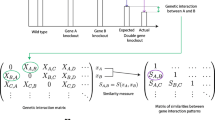Abstract
To investigate the structure of the genomic interaction network built from yeast gene-expression compendium dataset of hundreds of systematic perturbations, social affiliation network analysis methodologies were applied through quantifying various density, closeness and centrality measures and exploring core-periphery structures. Genes affected by a larger number of perturbations were found to be involved in responses to various environmental challenges. Deletion of essential genes was suggested to cause larger number of genes to be significantly up or down regulated. We explored the network structure made up of several sub-networks using core-periphery models to find ancient pathways. Glycolysis and TCA cycle have relatively core positions in the energy-related processes of yeast.
Preview
Unable to display preview. Download preview PDF.
Similar content being viewed by others
References
Wasserman, S., Faust, K.: Social Network Analysis. Cambridge University Press, Cambridge (1994)
Scott, J.: Social Network Analysis. SAGE publications, Thousand Oaks (2000)
Hughes, T.R., Marton, M.J., Jones, A.R., Roberts, C.J., Stoughton, R., Armour, C.D., Bennett, H.A., Coffey, E., Dai, H., He, Y.D., Kidd, M.J., King, A.M., Meyer, M.R., Slade, D., Lum, P.Y., Stepaniants, S.B., Shoemaker, D.D., Gachotte, D., Chakraburtty, K., Simon, J., Bard, M., Friend, S.H.: Functional discovery via a compendium of expression profiles. Cell 102, 109–126 (2000)
Cohen, B.A., Pilpel, Y., Mitra, R.D., Church, G.M.: Discrimination between Paralogs using Microarray Analysis: Application to the Yap1p and Yap2p Transcriptional Networks. Mol. Biol. Cell 13(5), 1608–1614 (2002)
Rung, J., Schlitt, T., Brazma, A., Freivalds, K., Vilo, J.: Building and analysing genome-wide gene disruption networks. Bioinformatics suppl. 2, 202–210 (2002)
Asch, J., Rindone, W., Church, G.M.: Systematic management and analysis of yeast gene expression data. Genome Research 10, 431–445 (2000)
Ihmels, J., Friedlander, G., Bergmann, S., Sarig, O., Ziv, Y., Barkai, N.: Revealing modular organization in the yeast transcriptional network. Nature Genetics 31, 370–377 (2002)
Faust, K.: Centrality in affiliation networks. Social Networks 19, 157–191 (1997)
Borgatti, S.P., Everett, M.G.: Network analysis of 2-mode data. Social Networks 19, 243–269 (1997)
Borgatti, S.P., Everett, M.G., Freeman, L.C.: Ucinet for Windows: Software for Social Network Analysis, Harvard Analytic Technologies USA (2002)
Freeman, L.C.: Centrality in social networks. Social Networks 1, 215–239 (1979)
Borgatti, S.P., Everett, M.G.: Models of Core/Periphery Structures. Social Networks 21, 375–395 (1999)
Mewes, H.W., Frishman, D., Guldener, U., Mannhaupt, G., Mayer, K., Mokrejs, M., Morgenstern, B., Munsterkotter, M., Rudd, S., Weil, B.: MIPS: a database for genomes and protein sequences. Nucleic Acids Res. 30, 31–34 (2002)
Featherstone, D.E., Broadie, K.: Wrestling with pleiotropy: genomic and topological analysis of the yeast gene expression network. BioEssays 24, 267–274 (2002)
Jeong, H., Mason, S.P., Barabasi, A.L., Oltvai, Z.N.: Lethality and centrality in protein networks. Nature 411, 41–42 (2001)
Wagner, A., Fell, D.A.: The small world inside large metabolic networks. Proc. R. Soc. Lond. 268, 1803–1810 (2001)
Przybyla-Zawislak, B., Gadde, D.M., Ducharme, K., McCammon, M.T.: Genetic and biochemical interactions involving tricarboxylic acid cycle (TCA) function using a collection of mutants defective in all TCA cycle genes. Genetics 152(1), 153–166 (1999)
Barabasi, A.L., Oltvai, Z.N.: Network Biology: Understanding the cell’s functional organization. Nature genetics 5, 101–113 (2004)
Author information
Authors and Affiliations
Editor information
Editors and Affiliations
Rights and permissions
Copyright information
© 2006 Springer-Verlag Berlin Heidelberg
About this paper
Cite this paper
Ohn, J.H., Kim, J., Kim, J.H. (2006). On the Society of Genome: Social Affiliation Network Analysis of Microarray Data. In: Wang, L., Jiao, L., Shi, G., Li, X., Liu, J. (eds) Fuzzy Systems and Knowledge Discovery. FSKD 2006. Lecture Notes in Computer Science(), vol 4223. Springer, Berlin, Heidelberg. https://doi.org/10.1007/11881599_132
Download citation
DOI: https://doi.org/10.1007/11881599_132
Publisher Name: Springer, Berlin, Heidelberg
Print ISBN: 978-3-540-45916-3
Online ISBN: 978-3-540-45917-0
eBook Packages: Computer ScienceComputer Science (R0)




